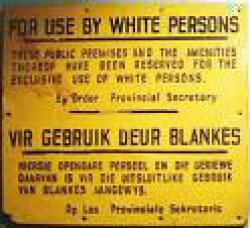
Published date
15 October 1990
The Reservation of Separate Amenities Act, Act No 49 of 1953, formed part of the apartheid system of racial segregation in South Africa. The Act enforced segregation of all public facilities, including buildings, and transport, in order to limit contact between the different races in South Africa. The Act also stated that the facilities for different races did not need to be equal. In practice then, the best facilities were reserved for whites while those for other races were inferior.
The act was part of the system of "petty apartheid," the name given to apartheid laws concerned with the regulation of day-to-day life, most notably the Immorality Act, Mixed marriages Act, and the Separate Amenities Act. Petty apartheid is sometimes compared with similar Jim Crow laws in the United States. Unlike Jim Crow however, petty apartheid made no effort to create the legal fiction of "separate but equal" public facilities.
Under F.W. De Klerk, the National party dismantled the entire system of petty apartheid by the time of 1994 general election that brought the ANC to power.
References
South African History Archives(SAHA), "15 October marks 22 years since the Reservation of Separate Amenities Act was repealed", From South African History Archives(SAHA),[Online] available at:www.saha.org.za,[Accessed: 08 October 2013] |
South African History Online(SAHO), "General South African History Timeline: 1950s", From South African History Online(SAHO),[Online] available at: www.sahistory.org.za ,[Accessed: 08 October 2013]